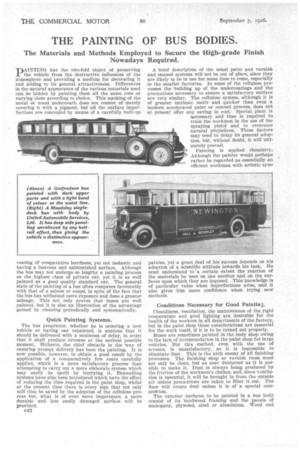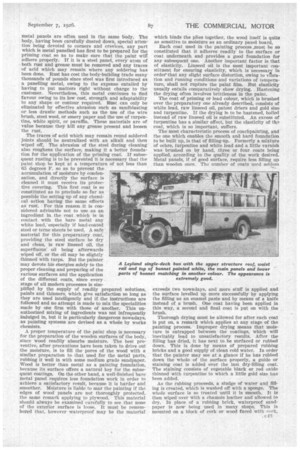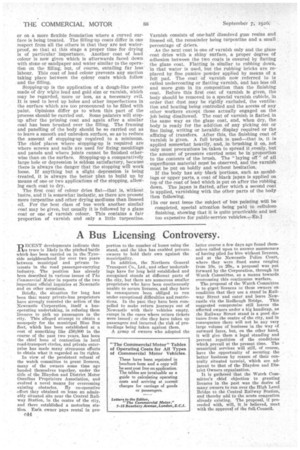THE PAINTING OF BUS• BODIES.
Page 64

Page 65

Page 66

If you've noticed an error in this article please click here to report it so we can fix it.
The Materials and Methods Employed to Secure the High-grade Finish Nowadays Required.
TIAINTING has the two-fold object of preserving
the vehicle from the destructive influences of the atmosphere and providing a medium for decorating it and adding to its general attractiveness. Differences in the natural appearance of the various materials used can be hidden by painting them all the same tone or varying them according to choice. This masking of the metal or wood underneath does not consist of merely covering it with a pigment, but all the surface imperfections are concealed by means of a carefully built-up
coating of comparative hardness, yet not inelastic and having a lustrous and unblemished surface. Although the bus may not undergo so lengthy a painting process as the highest class of private car, yet it is as well painted as a good quality standard car. The general state of the painting of a bus often compares favourably with that of a saloon or coupe, in spite of the fact that the bus has withstood more exposure and done a greater mileage. This not only proves that buses are well painted, but it is also an illustration of the advantage gained by cleaning periodically and systematically.
Quick Painting Systems.
The bus proprietor, whether he is ordering a new vehicle or having one repainted, is anxious that it should be delivered with a minimum of delay, in order that it shall produce revenue at the earliest possible moment. Hitherto, the chief obstacle in the way of ensuring prompt delivery has been the painting. It is now possible, however, to obtain a good result by the application of a comparatively few coats carefully applied, which is a more satisfactory process than attempting to carry out a more elaborate system which may easily be spoilt by hurrying it. Enamelling systems have also been introduced which have the effect of reducing the time required in the paint shop, whilst at the present time there is every sign that not only will time be saved by the adoption of the cellulose process but, what is of even more importance, a more durable and less easily damaged surface will be provided.
042 A brief description of the usual paint and varnish and enamel systems will not be out of place, since they are likely to be in use for some time to come, especially in the smaller factories. In some of the cellulose processes the building up of the undercoatings and the precautions necessary to ensure a satisfactory surface are very similar. The cellulose 'system, although it is of greater intrinsic merit and quicker than even . a modern accelerated paint or enamel process, does not at present offer any saving in cost. Special plant is necessary and time is required to train the workmen in the use of the spraying pistol and to overcome natural prejudices. These factors may tend to delay its general adop tion, but, without doubt, it win ulti mately prevail.
Painting is applied chemistry. Although the painter would perhaps rather be regarded as essentially an efficient workman with artistic sym
pathies, yet a great deal of his success depends on his adoption of a scientific attitude towards his task. He must understand to a certain extent the reaction of the materials he uses on one another and on the surfaces upon which they are imposed. This knowledge is of particular value when imperfections arise, and it also giveshim more confidence when trying new methods.
Conditions Necessary for Good Paintin2.
Cleanliness, ventilation, the maintenance of the right temperature and good lighting are desirable for the health of the workers in all departments of the factory, but in the paint shop these considerations are essential for the work itself, if it is to be turned out properly.
Buses are sometimes painted in the body shop owing to the lack of accommodation in the paint shop for large vehicles. But this method, even with the use of screens, is unsatisfactory, as it is impossible to eliminate dust. This is the arch enemy of all finishing processes. The finishing shop or varnish room must not only be clean, but as near dustproof as it is possible to make it. Dust is always being produced by the friction of the workmen's clothes, and, since ventilation is essential, it will be brought in from the outside air unless precautions are taken to filter it, out. The floor will create dust unless it is of a special composition.
The exterior surfaces to be painted in a bus body consist of its hardwood framing and the panels of mahogany, plywood, steel or aluminium. Wood and metal panels are often used in the same body. The body, having been carefully dusted down, special attention being devoted to corners and crevices, any part which is metal panelled has first to be prepared for the priming coat so as to make sure that the paint will adhere properly. If it is a steel panel, every atom of both rust and grease must be removed and any traces of acid which may remain where any soldering has been done. Rust has cost the body-building trade many thousands of pounds since steel was first introduced as a panelling metal, owing to the expense entailed by having to put matters right without charge to the customer. Nevertheless, this metal continues to find favour owing to its low cost, strength and adaptability to any shape or contour required. Rust can only be eliminated by effective abrasion such as sandblasting or less drastic methods such as the use of the wire brush, steel wool, or emery paper and the use of turpentine, white spirit, or paraffin. These materials are of value because they kill any grease present and loosen the rust.
The traces of acid which may remain round soldered joints should be neutralized with an alkali and then wiped off. The abrasion of the steel during cleaning also roughens the surface, making it a better foundation for the application of the priming coat If subsequent rusting is to be prevented it is necessary that the paint shop be kept at a temperature of not less than 65 degrees F. so as to prevent the accumulation of moisture by condensation, and directly the surface is cleaned it must receive its protective covering. This first coat is ,go constituted as to preclude so far as possible the setting up of any chemical action having the same effects as rust. For this reason it is considered advisable not to use as an ingredient in the coat which is in contact with the bare metal any white lead, especially if lead-coated steel or terne sheets be used. A safe material for this preparatory coat-, providing the steel surface be dry and clean, is raw linseed oil, the superfluous oil being afterwards wiped off, or the oil may be slightly thinned with turps. But the painter may devote his energies solely to the proper cleaning and preparing of the various surfaces and the application of the different coats, since every stage of all modern processes is simplified by the supply of readily prepared solutions, paints and thinners, which give satisfaction so long as they are used intelligently and if-the instructions are followed and no attempt is made to mix the specialities made by one firm with those of another. This unauthorized mixing of ingredients was not infrequently indulged in, but it is particularly dangerous nowadays, as painting systems are devised as a whole by works chemists.
A proper temperature of the paint shop is necessary for the preparation of the wooden surfaces or the body, since wood readily absorbs moisture. The best preventive, after precautions have been taken to drive out the moisture, is to fill the pores of the wood with a similar preparation to• that used for the metal parts, rubbing it well in with some medium grade sandpaper. Wood is better than metal as a painting foundation, because its surface offers a natural key for the subsequent coatings. On the other hand, a well-finished bare metal panel requires less foundation work in order to achieve a satisfactory result, because it is harder and ,smoother. Moisture is liable to mar the painting if the edges of wood panels are not thoroughly protected, the same remark applying to plywood. This material should always be examined carefully to see that none of the exterior surface is loose. It must be remembered that, however waterproof may be the material
which binds the plies together, the wood itself is quite as sensitive to moisture as an ordinary panel board,
Each coat used in the painting process .must be so constituted that it adheres readily to the surface or coat underneath and provides a good foundation for any subsequent one. Another important factor is that of elasticity. Linseed oil is the most important constituent for ensuring elasticity, which is necessary in order'-that any slight surface distortion, owing to vibration and running conditions and variations of temperature, shall not rupture the paint film. But elasticity usually entails comparatively show drying. Hastening the drying often involves brittleness in the paint.
The coat of priming or lead colour, which is brushed over the preparatory one already described, consists of white lead, raw linseed oil, patent driers and gold size and turpentine. If the drying is to be hastened, boiled instead of raw linseed oil is substituted. An excess of turpentine has a similar effect, but the elasticity of the coat, which is so important, suffers.
The most characteristic process of coachpainting, and the one which enables the smooth and hard foundation to be built up, is that of filling-up. Formerly a mixture of ochre, turpentine and white lead and a little varnish was brushed on by hand, three or four coats being applied, according to the quality of the work desired. Metal panels, if of good surface, require less filling up than wooden ones. The number of coats used seldom
exceeds two nowadays, and more stuff is applied and the surface levelled up more successfully by applying the filling as an enamel paste and by means of a knife instead of a brush. One coat having been applied in this way, a second and final coat is put on with the brush.
Thorough drying must be allowed for after each coat is put on, a remark which applies at any stage of the painting process. Improper drying means that moisture is entrapped between the coatings, which will inevitably lead to unsatisfactory results. After the filling has dried, it has next to be surfaced or rubbed down. This is done by means of prepared rubbing bricks and a good supply of clean cold water. In order that the painter may see at a glance if he has rubbed down the whole of the surface properly, a guide or staining coat is added over the last dry-filling coat. The staining consists of vegetable black or red oxide thinned with turpentine to which a little gold size has been added.
As the rubbing proceeds, a sludge of water and filling is created, which is washed off with a sponge. The whole surface is so treated until it is smooth. It is then wiped over with a chamois leather and allowed to dry. In place of a rubbing brick, waterproof sandpaper is now being used in many shops. This is mounted on a block of cork or wood faced with cork, or on a more flexible foundation where a curved surface is being treated. The filling-up coats differ in one respect from all the others in that they are not waterproof, so that at this stage a proper time for drying is of particular importance. Another coat of lead colour is now given which is afterwards faced down with stone or sandpaper and water similar to the operation on the filling, but, of course, entailing far less labour. This coat of lead colour prevents any suction taking place between the colour coats which follow and the filling.
Stopping-up is the application of a dough-like paste made of dry white lead and gold size or varnish, which may be regarded, more or less, as a necessary evil. It is used to level up holes and other imperfections in the surface which are too pronounced to be filled with paint. Opinions differ as to when this part of the process should be carried out. Some painters will stopup after the priming Coat and again after a similar coat has been brushed over the filling. The framing and panelling of the body should be so carried out as to leave a smooth and unbroken surface, so as to reduce the amount of stopping-up required to a minimum. The chief places where stopping-up. is required are where screws and nails are used for fixing mouldings and panels and where joints cannot be finished otherwise than on the surface. Stopping-up a comparatively large hole or depression is Seldom satisfactory, because them is always the danger that the stopping will work loose. If anything but a slight depression is being treated, it is always the better plan to build up by means of one or two applications of the stopping, allowing each coat to dry.
The first coat of colour dries flat—that is, without lustre, and it Is somewhat inelastic, as there are present more turpentine and other drying mediums than linseed oil. For the best class of bus work another similar coat may be given, but usually it is followed by a glaze coat or one of varnish colour. This contains a fair proportion of varnish and only a little turpentine. Varnish consists of one-half dissolved gum resins and linseed oil, the remainder being turpentine and a small percentage of driers.
As the next coat is one of varnish only and the glaze coat dries with a shiny surface, a proper degree of adhesion between the two coats is ensured by flatting the glaze coat. Flatting is similar to rubbing down, in that water is used, but the rubbing bricks are replaced by fine pumice powder applied by means of a felt pad. The coat of varnish now referred to is called undercoating or flatting varnish, and has less oil and more gum in its composition than the finishing coat. Before this first coat of varnish is given, the body should be removed to a special varnish cubicle, in order that dust may be rigidly excluded, the ventilation and heating being controlled and the access of any other workers except those actually engaged on the job being disallowed. The coat of varnish is flatted in the same way as the glaze coat, and, when dry, the body is ready for the addition of any picking out or fine lining, writing or heraldic display required or the affixing of transfers. After this, the finishing coat of varnish is given. A full brush is used—that is, it is applied somewhat heavily, and, in brushing it on, not only must precautions be taken to spread it ,evenly, but the amount of pressure exerted must be in proportion to the contents of the brush. The "laying off" of all superfluous material must be observed, and the varnish must be put on boldly and without hesitation. If the body has any black portions, such as mouldings or upper parts, a coat of black japan is applied on top of the coat of lead which is put on after the rubbing down. The japan is flatted, after which a second coat is applied, varnishing with the other parts of the body then following.
[In our next issue the subject of bus painting will be completed, special attention being paid to cellulose finishing, showing that it is quite practicable and not too expensive for public-service vehicles.-e-En.]












































































































